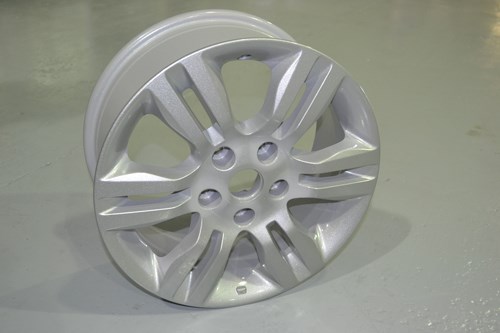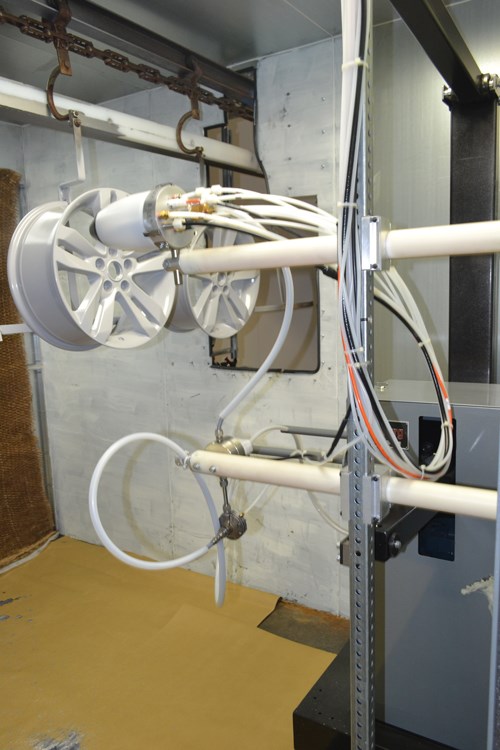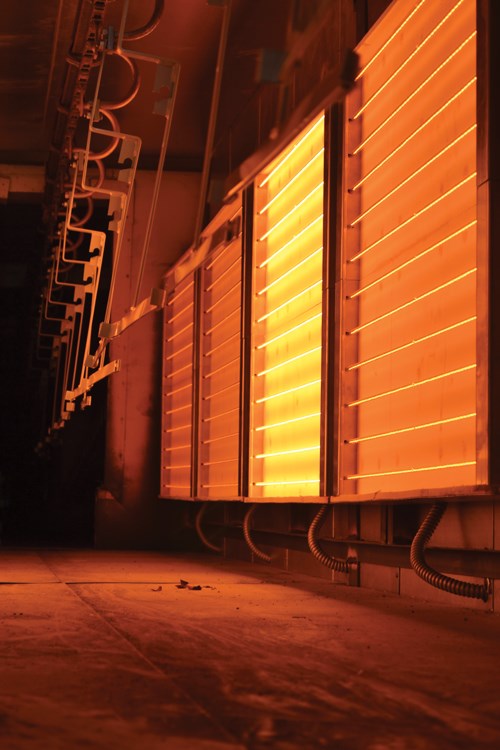Wheels of Fortune For a Florida Coater
Once a supplier to international companies, a Florida manufacturer now makes and coats its own aftermarket wheels after it discovered that 80 percent of the aftermarket wheel manufacturing business that used to be done in the U.S. is done overseas, and often not very well.
#masking #pollutioncontrol #curing
When Stiefel Aluminum, a smelter located just north of Tampa, noticed it was shipping more and more aluminum to other parts of the world for production of aftermarket wheels, it also sensed a void in that manufacturing process here in the U.S.
When the company dug deeper, it discovered that 80 percent of the aftermarket wheel manufacturing business used to be done in the U.S., but now that 80 percent is done overseas, and often not very well.
Featured Content
That number led Stiefel late in 2012 to launch SB Manufacturing in Dade City, Fla., an operation that is now in full production with a goal of producing more than one million wheels per year. Besides die-casting, machining and heat-treating the wheels, SB also has complete powder and waterborne liquid finishing lines that enable it to be a completely vertically integrated manufacturer.
“We’re going to be running 24 hours a day, seven days a week,” says Phil Tolsma, finishing manager for SB. “Our business is really going to boom, because our customers were just really tired of buying Chinese scrap.”

80 percent of aftermarket wheel manufacturing used to be done in the U.S., but now that 80 percent is done overseas.
More Than 100 Molds the First Month
In just the first month of full production, Tolsma says the company is in the process of producing more than 100 molds for aftermarket wheels, including a steady supply of Mazda and Nissan replica orders. More commercial customers are coming online every day, he says.
Wheels are a huge part of the aftermarket industry, says Chris Kersting, president and CEO of the Specialty Equipment Market Association (SEMA). Sales of automotive specialty-equipment products continued to climb in 2012 to reach more than $31 billion, according to the 2013 SEMA Annual Market Report, a 4-percent increase over the previous year and showing the third consecutive year of growth.
“Having experienced significant economic challenges over the past several years, the specialty-parts and accessories market is ready and eager to do business,” Kersting says. “Companies have a more positive outlook about the future and are finding ways to grow the market.”
It is for this reason that Stiefel Aluminum began thinking several years ago about getting into the aftermarket wheel industry, after having supplied other manufacturers with aluminum for decades.
The company created SB Manufacturing and researched several sites for a plant location, including in Ohio, Kentucky and Florida. SB was able to work out a suitable agreement with officials in Dade City to take over a building that formerly housed an orange juice manufacturer.
Lured by Incentives
The city actively went after SB and approved an incentive plan from the Florida Qualified Target Industry tax refund program. The company also was the first business locating in Pasco County to receive its Brownfield Job Creation Bonus. These performance-based state incentives mean that the refunds are awarded after job requirements have been met. William Kelley, SB general manager, said about 75 workers will eventually be employed at the plant.

When the primer is cured, the wheels move into a new water-based liquid finishing operation supplied by Finishing Brands that features a Ransburg Aerobell high-speed rotary atomizers mounted on a short-stroke reciprocator that can operate to speeds as fast as at 60,000 rpm.
After working out the details of the new facility—which is comprised of three 78,000-square-foot rooms that will house machining, finishing and warehousing/packaging—Tolsma was brought in to set up the finishing operations. A 30-year veteran of the finishing industry, Tolsma’s prior experience was coating ammunitions, so the aftermarket wheel sector was new ground for him. His first order of business was to purchase a used finishing line from a wheel manufacturer previously located in Ohio. That line was then taken apart and shipped to Florida where Tolsma’s crew re-assembled it and upgraded a few of its fixtures.
Improving the Finishing Line
“There definitely was some work that needed to be done on the line,” Tolsma says. “It was built in the early 2000s, but it was originally installed in Michigan and ran for five years, then torn down and moved to Ohio, so we had some work we needed to do on it.”
The finishing line—which actually had been three separate 1,000-foot lines—had been idle since 2009, so Tolsma had to replace some pumps and filters to get it operational again. He then reassembled it into a line that is just over 2,000 feet in length, which required new drive motors for the system.
When it came to the spray equipment, SB called on Finishing Brands of Toledo, Ohio, to install all new parts. The new installation includes products such as DeVilbiss, Ransburg, BGK and Binks spray-finishing, fluid-handling and electrostatic-spray equipment.
Gary Jacobsen, a Finishing Brands sales manager, says SB chose his company’s equipment after seeing a Class A1 automotive finishing application in Asia which was using Ransburg Rotary Bell technology.
.jpg;maxWidth=600)
SB had Finishing Brands install all new equipment to manage the system, including products such as DeVilbiss, Ransburg, BGK and Binks spray-finishing, fluid-handling and electrostatic-spray equipment.
“Our first meeting was last November, and we just started talking through the processes because we had a clean slate with the empty building,” Jacobsen says. “We could design our own blueprint of how we wanted this finishing line to run and where we wanted the stages. Then it came time to execute the plan.”
Starting with Scrap
The SB manufacturing process starts with the melting of scrap aluminum, and then the liquid metal is transferred and injected into four, low-pressure die-cast molding machines. After flash is removed from the castings and inspected, the castings are heat-treated, machined and sent into a 12-stage wash operation set up by Chemetall to enhance performance.
According to Tolsma, the eight-hour wash process was developed to replace hexavalent chrome technology for pre-paint aluminum preparation. He says it leaves a colorless, non-staining film that performs well with both full-painted and machine-faced wheels. Chemetall set the system up with a cleaner stage, a double rinse with virgin RO halos, a deoxidizer stage, another double rinse with virgin RO halos, then Chemetall’s Gardobond pretreatment, which is an aluminum conditioner and the first of a two-step conversion coating. After a double rinse with virgin DI halos, Chemetall’s second-step conversion coating, a self-assembling-molecules process known as SAM, is applied and followed by another double rinse with virgin DI halos.
Tolsma says SB chose the Chemetall process because it is a “green” process that has been in use since 2002 on more than 100 million wheels with equivalent or better field performance than hex-chrome technology for pre-paint aluminum preparation.
.jpg;maxWidth=600)
The wheels are run through the 2,000-foot line at 4 feet per minute and conveyed to a powder primer application using four automatic guns mounted on vertical reciprocators.
Powder and Liquid Finishing
The finishing process starts with an Akzo Nobel water-based epoxy powder coating, followed by a liquid topcoat and then an acrylic powder clear coat. The wheels are run through the 2,000-foot line at 4 feet per minute and conveyed to a powder primer application using four automatic guns mounted on vertical reciprocators. This is followed by a trip through a 20-foot IR oven that has three separate lines.
“The oven not only cures the powder primer, but it does double-duty to age-harden the wheels to the correct hardness,” Jacobsen says.
When the primer is cured, the wheels move into a new water-based liquid finishing operation supplied by Finishing Brands that features a Ransburg Aerobell high-speed rotary atomizer mounted on a short-stroke reciprocator that can operate to speeds as fast as 60,000 rpm. Jacobsen says the rotary bell produces a very fine atomization and transfer efficiency of 90+ percent, which he says virtually eliminates overspray.
A Ransburg Control Pac is used to control the high-voltage, shape-air turbine speed and digital outputs to trigger the bell, and a PLC system is used for automatic part tracking and triggering of the applicators. The fluid flow and automatic color change is controlled by a single-channel Ransflow metering system with a fiber optic flow meter. This system is designed to precisely deliver the correct amount of paint, and automatically changes and flushes the system when the recipe changes.
That’s important, because SB uses numerous colors and hues. More than 100 different recipes can be loaded into the system and accessed remotely near the spray station, or at the main control panel which also operates the IR curing modules located inside the convection oven. All facets of the recipe, including flow rate, atomization air, bell speed, etc., are accessible from the control panel. The voltage isolation for the waterborne coating being sprayed is provided by a Ransburg Aquablock 2 system.
Two Binks stationary, pneumatically-controlled automatic spray guns provide a focus spray in the recessed area of the wheel, while three Binks pumping systems supply material to Ransburg color-change stacks set up for six-color operation. The three pumping systems include a wall-mounted diaphragm pump with 55-gallon pickup tube, a back pressure regulator, and the necessary tubing and fittings.
Final Clear Powder
The now-liquid-coated wheels are then conveyed into the second lane of the gas convection oven prior to a final clear powder-coating operation using four powder-coating guns. SB also installed BGK IR heater panels to provide the initial stage of the final curing process in the gas convection oven to set the acrylic clear coat and prevent possible contamination of the liquid finish.

The wheels end up going through a 20-foot IR oven that has three separate lines.
When the wheels roll off the finish line, they will be sold here in the U.S. as well as overseas in Italy, Japan and other countries that have a high use for aftermarket products.
“It was a real luxury to be able to build the system from scratch and get some very high-quality suppliers in to help us get the line functioning properly,” Tolsma says. “We’ll do well in this market because we have quality wheels, and customers will know it from the first time they see the fit and finish.”
For information on suppliers in this story, visit: Finishing Brands at finishingbrands.com, Chemetall at chemetallamericas.com, and Akzo Nobel at akzonobel.com/aac.
RELATED CONTENT
-
Curing Oven Basics
Simply heating up the substrate does not cure the coating. There are many variables to consider when choosing the best cure oven for your application...
-
Understanding Paint Atomization
BASF coatings development expert Tim December explains how paint atomization works for both pneumatic spray applicators and high-speed rotary bell applicators.
-
Quality Finishing: Don’t Starve Your Spray Gun for Air!
Tips to Avoid Pressure Drop in Air Spraying


















